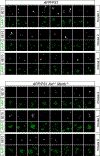Microglia use TAM receptors to detect and engulf amyloid β plaques
- PMID: 33859405
- PMCID: PMC8102389
- DOI: 10.1038/s41590-021-00913-5
Microglia use TAM receptors to detect and engulf amyloid β plaques
Abstract
Two microglial TAM receptor tyrosine kinases, Axl and Mer, have been linked to Alzheimer's disease, but their roles in disease have not been tested experimentally. We find that in Alzheimer's disease and its mouse models, induced expression of Axl and Mer in amyloid plaque-associated microglia was coupled to induced plaque decoration by the TAM ligand Gas6 and its co-ligand phosphatidylserine. In the APP/PS1 mouse model of Alzheimer's disease, genetic ablation of Axl and Mer resulted in microglia that were unable to normally detect, respond to, organize or phagocytose amyloid-β plaques. These major deficits notwithstanding, TAM-deficient APP/PS1 mice developed fewer dense-core plaques than APP/PS1 mice with normal microglia. Our findings reveal that the TAM system is an essential mediator of microglial recognition and engulfment of amyloid plaques and that TAM-driven microglial phagocytosis does not inhibit, but rather promotes, dense-core plaque development.
Conflict of interest statement
Figures














Comment in
-
TAM-ping down amyloid in Alzheimer's disease.Nat Immunol. 2021 May;22(5):543-544. doi: 10.1038/s41590-021-00918-0. Nat Immunol. 2021. PMID: 33859407 Free PMC article.
-
Dense-core plaques could be beneficial in AD.Nat Rev Neurol. 2021 Jun;17(6):328. doi: 10.1038/s41582-021-00513-9. Nat Rev Neurol. 2021. PMID: 33986528 No abstract available.
Similar articles
-
Gas6 induces inflammation and reduces plaque burden but worsens behavior in a sex-dependent manner in the APP/PS1 model of Alzheimer's disease.J Neuroinflammation. 2022 Feb 7;19(1):38. doi: 10.1186/s12974-022-02397-y. J Neuroinflammation. 2022. PMID: 35130912 Free PMC article.
-
TAM receptors regulate multiple features of microglial physiology.Nature. 2016 Apr 14;532(7598):240-244. doi: 10.1038/nature17630. Epub 2016 Apr 6. Nature. 2016. PMID: 27049947 Free PMC article.
-
Differential TAM receptor-ligand-phospholipid interactions delimit differential TAM bioactivities.Elife. 2014 Sep 29;3:e03385. doi: 10.7554/eLife.03385. Elife. 2014. PMID: 25265470 Free PMC article.
-
TAM Receptor Pathways at the Crossroads of Neuroinflammation and Neurodegeneration.Dis Markers. 2019 Sep 15;2019:2387614. doi: 10.1155/2019/2387614. eCollection 2019. Dis Markers. 2019. PMID: 31636733 Free PMC article. Review.
-
New Insights into the Role of Tyro3, Axl, and Mer Receptors in Rheumatoid Arthritis.Dis Markers. 2020 Jan 19;2020:1614627. doi: 10.1155/2020/1614627. eCollection 2020. Dis Markers. 2020. PMID: 32051695 Free PMC article. Review.
Cited by
-
Cerebrospinal fluid proteomics in patients with Alzheimer's disease reveals five molecular subtypes with distinct genetic risk profiles.Nat Aging. 2024 Jan;4(1):33-47. doi: 10.1038/s43587-023-00550-7. Epub 2024 Jan 9. Nat Aging. 2024. PMID: 38195725 Free PMC article.
-
Bone Marrow-Derived GCA+ Immune Cells Drive Alzheimer's Disease Progression.Adv Sci (Weinh). 2023 Dec;10(36):e2303402. doi: 10.1002/advs.202303402. Epub 2023 Nov 10. Adv Sci (Weinh). 2023. PMID: 37949676 Free PMC article.
-
Aβ plaques do not protect against HSV-1 infection in a mouse model of familial Alzheimer's disease, and HSV-1 does not induce Aβ pathology in a model of late onset Alzheimer's disease.Brain Pathol. 2023 Jan;33(1):e13116. doi: 10.1111/bpa.13116. Epub 2022 Sep 5. Brain Pathol. 2023. PMID: 36064300 Free PMC article.
-
Chronic PPARγ Stimulation Shifts Amyloidosis to Higher Fibrillarity but Improves Cognition.Front Aging Neurosci. 2022 Mar 30;14:854031. doi: 10.3389/fnagi.2022.854031. eCollection 2022. Front Aging Neurosci. 2022. PMID: 35431893 Free PMC article.
-
Galectin-3, a rising star in modulating microglia activation under conditions of neurodegeneration.Cell Death Dis. 2022 Jul 20;13(7):628. doi: 10.1038/s41419-022-05058-3. Cell Death Dis. 2022. PMID: 35859075 Free PMC article. Review.
References
Publication types
MeSH terms
Substances
Grants and funding
LinkOut - more resources
Full Text Sources
Other Literature Sources
Medical
Molecular Biology Databases
Research Materials
Miscellaneous

